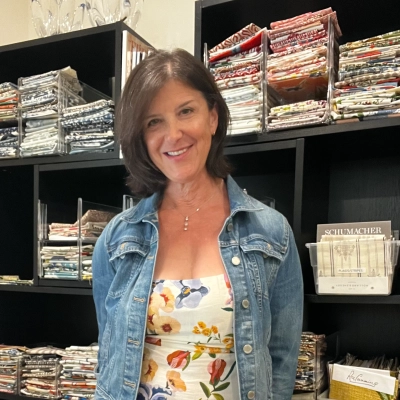18 Strategies for Decorating Small Spaces Without Clutter
Decorating small spaces can be a challenge, but with the right strategies, it's possible to create a stylish and functional living area without clutter. This article presents expert-backed techniques for maximizing space and enhancing the aesthetic appeal of compact rooms. From choosing lightweight furniture to optimizing vertical storage, these insights will help transform even the smallest spaces into comfortable and inviting environments.
- Choose Lightweight Furniture for Small Rooms
- Create Visual Zones Without Dividing Space
- Focus on Multifunctional Furniture and Vertical Design
- Organize Collections to Tell a Story
- Use Subtle Color Contrasts for Depth
- Anchor Room with One Standout Piece
- Balance Empty Space with Intentional Design
- Incorporate Bold Continuous Materials for Impact
- Prioritize Functional Storage as Decor
- Repair First, Then Design for Function
- Maximize Vertical Storage to Free Floor
- Optimize Lighting for Spacious Feel
- Establish Light Color Foundation for Openness
- Use Tall Plants to Maximize Vertical
- Create Focal Points with Strategic Artwork
- Keep Only Items That Add Value
- Amplify Space with Strategic Mirror Placement
- Personalize One Area at a Time
Choose Lightweight Furniture for Small Rooms
I've had more than 15 years of experience designing houses, furniture, and lovely rooms. My favorite design challenge is small rooms because they force me to carefully consider every item, every color, and every texture.
Pick the Right Size Furniture
Large pieces of furniture can make a room feel closed in. I always opt for pieces sized for the room and which are lightweight. A chair with skinny legs, a skinny sofa, or a skinny console can keep the room spacious and cozy at the same time. Scale is key with a small room.
Use Furniture That Does More Than One Thing
I adore multi-purpose furniture. An ottoman can store blankets and provide additional seating. A side table can be rolled around where needed. A small table can double as a console. These types of pieces keep the room functional without clutter.
Add Texture, Not Stuff
I add texture with things such as linen, wood, rattan, or gentle area rugs. Texture adds depth and a cozy feeling to a room without accumulating a lot of items. I frequently combine old and new pieces, adding personality and warmth to the room.
Let Light Work for You
Light makes a small space feel bigger and more welcoming. Mirrors reflect the room, light walls open it up, and glass or metallic accents keep it airy. I hang curtains higher than the window to make the ceilings feel taller.
Make the Room Feel Tall
I like to draw the eye upward. Tall shelves, vertical art, or hanging plants help the room feel spacious and calm. Even a small wall can have a big impact when you think vertically.
Keep It Personal
A small room is not a showroom. I add elements which are storytelling pieces: family photographs, favorite books, or a favorite vase. That gives it a feeling of being lived-in and loved. Small rooms are an opportunity to be innovative. With suitable furniture, texture, lighting, and touches of personality, even the smallest rooms become bright, snug, and lovely.

Create Visual Zones Without Dividing Space
Especially in small spaces, thoughtful editing, natural textures, and visual breathing room create a home that feels both spacious and soulful.
Here's a practical strategy that works beautifully:
Strategic zoning according to the senses:
- Define areas by action, but don't divide.
Even in a compact studio or apartment, create visual zones. For example, define a reading nook, a space for working, and a relaxing area by using a thin runner rug or a low-lined shelf. In my own small urban studio, I defined the "cozy corner" with a natural jute rug and a linen armchair under a moss wall panel—distinct, calm, and never crowded.
- Edit with intention.
Focus on 3-5 tactile natural and subtle elements, nothing too overbearing. In my space, that includes a bamboo hanging light, an abstract forest mural, a linen throw, and a few smooth ceramic vessels. Each element offers texture without competing, and together they are quite harmonious.
- Layer with light, not stuff.
Mirrors, light textiles, and soft lighting expand perception. We often recommend a light-tone linen curtain that allows gentle diffusion of daylight. Pair it with a strategic nature print or mural as it visually expands while keeping the room grounded in green serenity.
- Go vertical with greenery (but keep it lean).
Hanging a preserved moss frame or a slim planter above eye level draws the eye upward, opening up your space without adding clutter to floors or surfaces.
Anchor with nature, not more stuff.
A single nature mural, like a forest or abstract botanical print, adds depth and serenity. Brick wall or bookcase offshoot? Just one statement piece transforms the entire visual mood—no need for dozens of smaller objects.
This works because:
Visual calm is equal to mental calm. A curated palette and natural textures help reduce sensory overload, creating a soothing environment for the mind.
Function meets beauty. Every visible item earns its function, whether that is practical (a chair, a lamp) or inspiring (a botanical mural, a soft linen throw).
Design with biophilic clarity. Even in compact spaces, the right nature elements and the right way of layering them support wellness, clarity, and a sense of flow.
I hope these tips can help your spaces feel spacious, grounded, and connected with nature.
Focus on Multifunctional Furniture and Vertical Design
When working with smaller spaces, such as a condo in downtown Vancouver or a compact laneway home, the key is being intentional about every piece you bring into the room. In my opinion, small spaces only start to feel cluttered when you try to force in too many items that don't serve a real purpose.
One strategy I've personally used and recommended to clients is to focus on multi-functional furniture. For example, instead of a bulky coffee table, I'll suggest an ottoman with hidden storage or a slim console that doubles as a desk. It's not just about saving space; it's about making sure every piece is earning its spot in the room.
Another significant factor for me is vertical design. Instead of filling up the floor with extra shelving or storage bins, I encourage using wall-mounted shelves, floating cabinets, or even tall bookcases that draw the eye upward. It creates the feeling of more height and openness, which instantly makes a smaller room feel larger.
Lighting also plays a huge role. I avoid heavy drapes or dark corners because they can visually shrink a room. Using mirrors strategically and layering in different light sources, like sconces instead of table lamps, keeps the space bright and airy without adding clutter.
So, my approach always comes back to being deliberate: fewer, smarter pieces that are functional, visually light, and tailored to the way you actually live in the space.

Organize Collections to Tell a Story
The best-decorated spaces are ones that have collections. I love when my clients own collections they've gathered over time. There's no need to avoid showing them off if they're organized, possibly by theme or even just by color. For example, think about grouping and stacking books according to color. Visually, your eyes process information more easily this way, creating a sense of order and calm. The goal is to let the collection tell a story while giving it room to breathe. When small spaces are displayed with intention, even a small space feels curated, not cluttered.

Use Subtle Color Contrasts for Depth
When I think about decorating a small space, the first thing that comes to mind is color. The walls in a tiny room can either make it feel like a cozy retreat or a suffocating box, so paint becomes your secret weapon. One specific strategy that has completely transformed my small office is choosing a cohesive palette with subtle contrasts rather than wild color changes. Stick to soft, light tones for the main walls like pale greys, warm creams, or muted pastels. These kinds of shades reflect light. They instantly make a room feel bigger, brighter, and less cramped.
But here's the trick that really makes it work. Instead of painting all of the walls the same color, I usually select one wall to highlight with a slightly deeper or more vibrant shade. It doesn't have to scream "accent wall"... just a gentle variation that draws the eye naturally. This creates depth, gives the room personality, and keeps the space from feeling flat or boxed in. For instance, in a tiny bedroom, I used a soft dove grey everywhere, but the wall behind the bed is a slightly richer charcoal. It didn't overpower the room, but it made the bed feel anchored and intentional rather than like it was floating in an undefined space.

Anchor Room with One Standout Piece
Choose one piece that you truly adore. That's where I begin. For me, it was a hand-carved leather chair. Placing it in the corner instantly set the mood of the room. Everything else simply worked around that.
Keep the rest minimal. A rustic wood side table with iron legs, a single rawhide lamp, perhaps one framed print of a western landscape. That's all. I've learned the hard way that accumulating too many accents makes a small room feel cramped quickly. When I reduced the number of items, the space felt larger, more tranquil, and more authentic.
Lighting is more important than most people realize. I replaced a bulky lamp with slim wall sconces featuring western detailing, and suddenly the room felt more spacious. You experience the warmth without sacrificing space.
The key is restraint. Western style has strong lines, textures, and character. One or two solid pieces can define an entire room. You don't need the entire catalog. And truthfully, it feels better when you enter a room where every item has a purpose for being there.

Balance Empty Space with Intentional Design
When decorating a small space, I think the same way I do when arranging flowers: the empty space matters as much as the blooms. In a bouquet, too many stems crammed together lose their beauty — and the same goes for rooms.
It's common for people to dislike leaving gaps because they feel bland, but in small spaces, that often leads to clutter. Empty space is fine as long as it's intentional. Planning and organizing well makes the difference — for example, leaving a clear stretch of wall above a sofa while anchoring the room with one statement piece of art creates balance instead of crowding.
Alongside floristry, I also studied interior design, and both fields taught me that thoughtful restraint often makes the strongest impression.
Incorporate Bold Continuous Materials for Impact
The most effective way I've found to make a small space feel expansive is to use one bold, continuous material rather than layering multiple competing elements. Instead of cluttering a room with decor, I've designed projects where reclaimed limestone or travertine runs from the floor straight up the wall, creating a seamless plane that acts as both structure and art. This approach contradicts the typical advice of "keep things light and minimal." In truth, minimalism often makes small spaces look unfinished. A strong, monolithic feature adds weight and character, while eliminating the need for excess ornamentation.
For example, a client in a compact coastal home opted for reclaimed French stone as a single accent wall. The texture and natural variation of the material gave depth and visual intrigue, while keeping the rest of the furnishings sparse. The result was a space that felt intentional, elevated, and surprisingly larger because the eye followed one uninterrupted flow rather than bouncing between many small distractions.

Prioritize Functional Storage as Decor
When decorating a small space, my main strategy is to prioritize functional storage that doubles as decor. For example, I use open shelving to neatly store and display board games in their rightful place. This way, they stay organized and easily accessible, while also adding personality to the room since colorful boxes and designs become part of the aesthetic. By keeping items vertical rather than spread out, the space feels taller and less crowded. I also make sure every piece of furniture has a purpose—like a coffee table with hidden storage. This approach has worked well for me because it balances style with practicality, keeping the room cozy and lively without slipping into clutter.

Repair First, Then Design for Function
In designing a small room, I always begin with function. At HomeFirst, where I work with home repairs daily, I have discovered that you cannot build a comfortable room on shaky ground. If the ceiling is leaking or a wall is damaged, I ensure that those issues are fixed before adding anything to the room. Otherwise, everything you place will accentuate the defects rather than making the room better. After the space is structurally sound, you can proceed with the design.
Next is ensuring every piece of furniture deserves its spot. In a certain project, I included a storage bench that served as additional seating and stored clutter. This prevented the necessity of several discrete pieces that would flood the space. These pieces keep the space open, and once repairs are done, I add a few simple touches for style. A couple of framed prints, a houseplant, or a textural throw can warm without cluttering. By following this order of repairing first, function second, and style last, you create a space that feels both functional and warm.

Maximize Vertical Storage to Free Floor
A strategy that consistently works is prioritizing vertical storage over horizontal surfaces. In one small apartment, we installed floating shelves and tall, narrow cabinets, which drew the eye upward and freed up floor space. Decorative items were limited to a few intentional pieces on those shelves, while daily-use items were stored out of sight.
The result was a space that felt open and organized without sacrificing personality. The key was restraint—choosing fewer items but arranging them thoughtfully. This approach created breathing room while still allowing the space to reflect character and function effectively for everyday living.

Optimize Lighting for Spacious Feel
We are used to thinking about clutter in a physical sense, like furniture, but light fixtures and the color of the light itself can open rooms up or make them feel even smaller. The key to making small spaces feel larger is maintaining open sightlines and letting the room 'flow' so the eye never rests on any bulky object or sudden tone change. The more you keep light variations smooth and fixture profiles minimal, the more the space will flow and the bigger it will feel.
We talk with a lot of customers, and here is what we always advise to those looking to revamp their small spaces:
1) Keep fixtures out of the way - Swap bulky last-century dome lights for trimless recessed fixtures that disappear into the ceiling, freeing up vertical space and preventing ceiling sightline clutter. If you're a renter, you can mount disk lights in place of the domes - all you need is a little know-how, no ceiling cutting or rewiring needed.
2) Light evenly to extend sightlines - Evenly spaced ceiling lights eliminate shadows and dark corners. When light levels are consistent, the eye can move smoothly from edge to edge, making the room feel more expansive.
3) Choose light colors that feel open - Neutral-to-cool whites (around 3500K-4000K) keep spaces bright and airy. By contrast, amber-toned light creates intimacy but can visually pull walls inward, making small spaces feel even smaller.

Establish Light Color Foundation for Openness
The biggest recommendation I have for your small space is establishing a good color foundation. I always recommend using lighter colors in small rooms or spaces, as they will really open up the area and create the impression of more room. Darker wall colors, in particular, can make a small space feel cluttered and cramped by default. Painting the ceiling in a smaller room can also help open up these spaces, since a contrasting ceiling color will draw the eye upward and give more of a sense of visual size.
Use Tall Plants to Maximize Vertical
I've had good success decorating small spaces in my own home by using taller decor to maximize vertical space and avoid clutter on the horizontal. In particular, I've found that taller houseplants placed strategically, specifically around windows, can help open up a small room without introducing clutter. Fiddle-leaf figs, monstera, parlor palms, etc., can all be good choices here.
Create Focal Points with Strategic Artwork
One strategy I recommend to clients with small spaces is to have one or two larger artworks that serve as bold focal points without overwhelming the room. On the other hand, creating a gallery wall of smaller pieces can be just as effective, as long as the frames or colors are consistent, because it reads as a single, curated statement rather than clutter. Both approaches keep the space intentional and polished, while also allowing personality to shine through.

Keep Only Items That Add Value
When I downsized from my larger Glendale home to a smaller apartment near LAX, I discovered the key to decorating small spaces is being ruthlessly intentional about every item. I learned to only keep possessions that truly add value to my daily life, which naturally prevents clutter from accumulating. This approach transformed my smaller space into something that feels more peaceful and functional than my previous larger home. The strategy is simple but effective: regularly assess whether each decorative element or furniture piece earns its place through either utility or genuine joy.

Amplify Space with Strategic Mirror Placement
When working with smaller homes in our Dallas listings, one strategy we lean on repeatedly is the use of mirrors to amplify natural light.
By placing a mirror opposite or adjacent to a window, it reflects sunlight and creates the effect of a second light source, which immediately opens up the room.
This trick is invaluable because many buyers equate light and openness with livability.
Instead of adding clutter through accessories or furniture, a well-placed mirror transforms how buyers perceive the space while keeping the staging minimal and modern.

Personalize One Area at a Time
When decorating small spaces, I find it most effective to tackle one area at a time rather than trying to design the entire space at once. During my move to Las Vegas, I discovered that personalizing just one corner with meaningful photos and a favorite chair created a sense of home without overwhelming the limited space. This focused approach prevents clutter while still allowing for personal expression in your living environment. Starting with a single, well-designed area gives you a foundation to build upon as you become more familiar with how you use the space.






